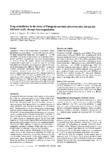Drug assimilation in the tissue of European sea bass (Dicentrarchus labrax) fry delivered orally through bioencapsulation
Share
စိတ္တဇ
Assimilation levels of the antibacterials trimethoprim (TMP) and sulfamethoxazole (SMX) in sea bass (Dicentrarchus labrax) fry tissue administered orally were investigated. A 1:5 TMP and SMX combination incorporated in an oil emulsion (Selco) at 20 % and 40 % concentrations (w/w) were bioencapsulated in Artemia (Instar II) nauplii. Chemotherapeutics-loaded ('medicated) nauplii were fed to the sea bass fry and drug concentrations in the tissue were analysed by high-performance liquid chromatrography (HPLC). Fish fed 40 %'medicated Artemia assimilated significantly higher levels of chemotherapeutics compared with those fed 20 %'medicated' Artemia. Chemotherapeutics given at 40 % reached peak levels (19.3 μg TMP/g DW and 23.31 μg SMX/g DW) within 2 h while those at 20 % peaked (8.74 μg TMP/g DW and 6.73 fig SMX/g DW) after 5 h. TMP persisted in the tissues longer (up to 72 h) than SMX (12–16 h), suggesting a more efficient uptake and retention of the former and/or faster metabolism and elimination of the latter.
Suggested Citation
Gapasin, R. S. J., Nelis, H. J., Chair, M., & Sorgeloos, P. (1996). Drug assimilation in the tissue of European sea bass (Dicentrarchus labrax) fry delivered orally through bioencapsulation. Journal of Applied Ichthyology , 12(1), 39-42. https://doi.org/10.1111/j.1439-0426.1996.tb00057.x
ဘာသာရပ်
စုစည်းမှုများ စုစည်းမှုများ
- AQD Journal Articles [1249]

